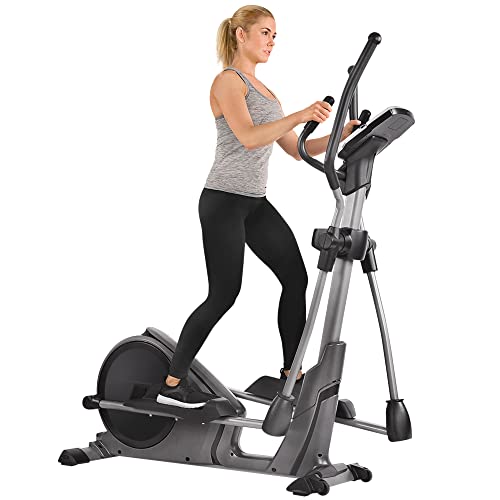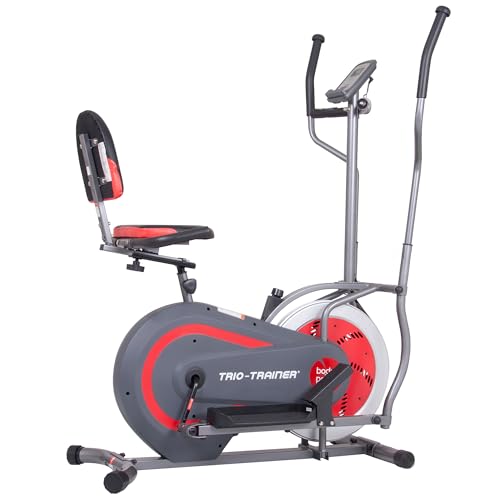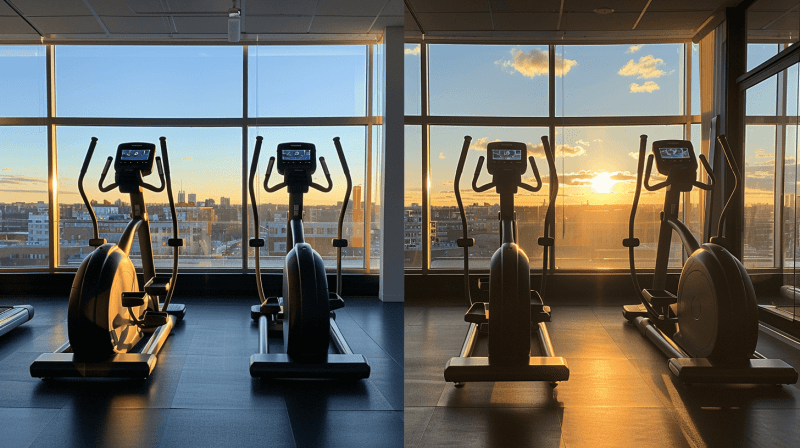You might be surprised to learn that the elliptical machine can be more effective for belly fat reduction than traditional running, as it allows for simultaneous upper and lower body engagement while minimizing joint stress. If you're looking to flatten your stomach, you'll need more than just mindless pedaling - it's about combining proper form, strategic intervals, and targeted core activation. While many people spend hours on cardio machines without seeing results, there's a science-backed approach that can transform your elliptical sessions into powerful fat-burning workouts. Let's explore the proven techniques that make the difference between wasting time and achieving real results.
Key Takeaways
-
Perform High-Intensity Interval Training (HIIT) on the elliptical, alternating between intense 30-second bursts and 90-second recovery periods.
-
Maintain proper posture with engaged core muscles and avoid leaning on handles to maximize abdominal muscle activation.
-
Combine elliptical workouts with a balanced diet and incorporate strength training to promote overall fat loss.
-
Use varied resistance levels and incline settings to increase calorie burn and engage more muscle groups.
-
Exercise consistently for at least 30 minutes, 4-5 times per week, while maintaining your target heart rate zone.
Understanding Belly Fat Basics
What makes belly fat particularly concerning is its connection to serious health conditions. When you increase your fat storage around your midsection, you're at higher risk for type 2 diabetes and heart disease. The good news is that regular cardio work, like using an elliptical machine, can help you burn calories effectively and lose fat throughout your body, including your belly region. Both subcutaneous and visceral fat contribute to excess belly fat, with visceral fat being especially dangerous due to its inflammatory effects.
Proper Elliptical Form
To maximize fat burning on the elliptical, you'll need proper form before increasing intensity or duration. Body positioning is key to engaging your core muscles effectively and preventing strain on your back and joints. Start by placing your feet firmly in the center of the pedals, ensuring your entire foot makes contact with each platform.
Keep an upright posture throughout your workout, with your chest lifted and shoulders pulled back. While it's tempting to lean forward, especially when you're tired, maintaining proper alignment helps target your abdominal muscles and supports better breathing. Your spine should remain neutral, and your gaze should focus straight ahead.
When using the moving handlebars, coordinate your push and pull movements with your leg stride to create a smooth, full body workout. Don't grip the handles too tightly - maintain a light but secure hold that allows natural arm movement. If you're using the stationary handles, keep your core engaged and your elbows slightly bent. Remember that proper form not only enhances belly fat reduction but also prevents injuries and increases your overall workout efficiency. The low-impact nature of the elliptical makes it an excellent choice for protecting your joints while working toward a flat stomach.
High-Intensity Interval Training Benefits
High-intensity interval training stands out from traditional elliptical workouts due to its powerful impact on abdominal fat reduction. When you incorporate HIIT on the elliptical machine, you'll burn more calories and specifically target stubborn visceral fat, which responds particularly well to this training method.
While interval training varies in intensity, research shows that working at above 90% of your peak heart rate can help you lose body fat more effectively than lower-intensity exercises. You'll want to structure your elliptical machines workout with alternating periods of high and low intensity, typically following a pattern of 45 seconds at 70-80% of your maximum heart rate, followed by 15 seconds at 50-60%.
The key to achieving a flat stomach through HIIT isn't just about creating a calorie deficit - it's about targeting specific fat deposits. When combined with weight training, HIIT can reduce abdominal fat mass twice as effectively as it reduces overall body fat. For ideal results, focus on maintaining proper form during your high-intensity intervals while ensuring you're pushing yourself to reach the appropriate heart rate zones for maximum fat-burning benefits. A 150-pound person can expect to burn approximately 350 calories during a moderate 30-minute elliptical session.
Strategic Workout Programming
Creating an effective elliptical workout program requires strategic planning and careful attention to progression. To effectively target belly fat deposits and Deep abdominal fat, you'll need to move beyond maintaining an almost constant heart rate during your sessions. Instead, structure your Elliptical Workouts to include deliberate variations in intensity, resistance, and movement patterns.
To optimize your fitness goals and Lose Fat, you'll want to gradually increase the intensity of your workouts over time. Start by using the elliptical at a moderate pace, then systematically incorporate intervals that challenge your body composition. You can achieve this by alternating between high-resistance segments and recovery periods, while engaging both your upper and lower body throughout the movement.
Consider incorporating 120-140 BPM music to maintain a consistent rhythm during your workout sessions. Complement your cardio sessions with strength training to enhance results. When you're on the machine, maintain proper form and utilize the handles to engage your core muscles more effectively. Change your workout direction periodically, shifting between forward and reverse pedaling to target different muscle groups and prevent adaptation. This thorough approach guarantees continuous progress toward your flat stomach goals while preventing fitness plateaus.
Core Engagement Techniques
Proper core engagement serves as the foundation for maximizing your elliptical workout results. To effectively target your abdominal muscles, maintain proper posture while holding the handles lightly, keeping your core engaged throughout the entire movement. You'll want to practice abdominal bracing techniques, like the stomach vacuum exercise, which can dramatically enhance your core activation during your elliptical sessions.
Low impact exercise on the elliptical helps protect your joints while building core strength and stability. To intensify your workout and engage your oblique muscles, incorporate controlled twisting motions and side-to-side movements while maintaining stability on the machine. You can further challenge your core by adjusting the resistance and incline settings, which will increase both muscle activation and calorie burn during your training sessions.
For ideal results, complement your elliptical workouts with dedicated core-strengthening exercises. Adding planks and crunches to your routine will help develop stronger abdominal muscles and contribute to a more defined midsection. Remember to maintain consistent form throughout your workout, as proper technique guarantees maximum engagement of your target muscle groups and helps prevent unnecessary strain on your back and neck.
Beyond The Elliptical Machine
While the elliptical machine offers an excellent foundation for achieving a flat stomach, your journey doesn't end when you step off the equipment. Your success depends on implementing a comprehensive approach that includes strategic dietary changes, focusing on proper calorie intake and increased protein consumption to support your fitness goals.
To maximize your results, you'll need to incorporate strength training exercises that specifically target your abdominal muscles, as these movements complement your cardio workouts. Consider adding high-intensity interval training (HIIT) to your routine, as it's proven more effective than steady-state cardio for reducing belly fat and improving overall body composition.
Don't underestimate the importance of recovery and lifestyle factors in your flat stomach journey. Proper sleep and stress management play pivotal roles in regulating hormones that affect fat storage and metabolism. Since genetics can influence where your body stores fat, you'll need to focus on all these elements together: exercise variety, nutrition, and recovery. The low-impact design of elliptical machines allows you to maintain intense workouts without risking joint strain or injury. By combining regular elliptical workouts with these additional strategies, you'll create a more effective and sustainable approach to achieving your flat stomach goals.
Frequently Asked Questions
Does the Elliptical Flatten Your Stomach?
While the elliptical can't directly flatten your stomach, it's part of an efficient workout routine. You'll need a balanced nutrition plan, high-intensity interval training, and supplemental strength training to reduce overall body fat.
How Long on the Elliptical to Lose Belly Fat?
You'll need 30-60 minutes of steady-state cardio or 20-30 minutes of high-intensity interval training on your elliptical, 4-5 times weekly. Combine with proper nutrition and monitor progress for effective belly fat reduction.
What Exercise Burns the Most Belly Fat?
Like a raging fire burning through wood, HIIT cardio sessions torch belly fat most effectively. You'll see better results combining these intense bursts with weighted abdominal exercises and metabolic resistance training than steady-state cardio alone.
Is 30 Minutes a Day on the Elliptical Enough to Lose Weight?
While 30 minutes of elliptical workout can help you lose weight, you'll see better results by increasing intensity, incorporating intervals, and maintaining a calorie deficit through proper diet alongside your low-impact cardio routine.
Conclusion
While you might worry that the elliptical machine alone won't deliver the flat stomach you're seeking, you'll achieve better results by combining proper form, HIIT training, and consistent core engagement. Don't let initial progress plateaus discourage you - stay committed to your workout programming and complement your elliptical sessions with strength training. When you maintain proper form and follow a strategic approach, you'll steadily progress toward your fitness goals.







